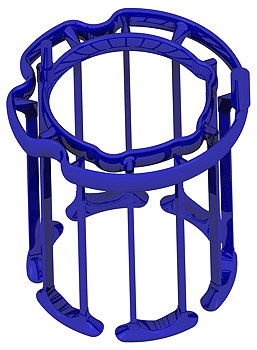German researchers are developing a new cooling concept for electric motors that uses polymers in the motor housings, resulting in lightweight motors with high power densities and efficiencies. The motors are aimed, in particular, at electric vehicle applications where these characteristics, combined with the motor¡¯s small size, will help to save weight and space.
The researchers ¨C from the Fraunhofer Institute for Chemical Technology (ICT), the Institute of Vehicle System Technology (Fast) and the Institute of Electrical Engineering (ETI) at Karlsruhe Institute of Technology -¨C are developing a novel approach in which the motor¡¯s stator and rotor are cooled directly. The work is part of a project known as DEmiL (from the German abbreviation for ¡°directly-cooled electric motor with integrated lightweight housing¡±). Conventional motors typically operate with efficiencies of more than 90%, which means that a high proportion of the electrical energy supplied to them is converted into mechanical energy. The remaining 10% is lost as heat. Most of this heat is lost in the stator¡¯s copper windings. To prevent motors from overheating, the heat is usually conducted away from the stator via a metal housing to a water-filled sleeve. In the German project, the researchers have redesigned the motor¡¯s stator, replacing the usual round winding wires with flat, rectangular wires that can be wound more tightly, creating space for a cooling channel next to the winding phases. ¡°In this optimised design, the heat losses can be dissipated through the cooling channel inside the stator, eliminating the need to transport the heat through the metal housing to an exterior cooling sleeve,¡± explains Robert Maertens, a researcher at Fraunhofer ICT. ¡°In fact, you no longer need a cooling sleeve at all. ¡°It offers other benefits, too,¡± he adds, ¡°including lower thermal inertia and higher continuous output from the motor¡±. In addition, the rotor cooling system also allows the rotor¡¯s heat loss to be dissipated directly within the motor. By dissipating the heat close to where it is generated, the researchers have been able to build the entire motor and housing from polymer materials, leading to further advantages. The metal usually needed to conduct heat from the stator can be replaced by the polymer materials, which have a lower thermal conductivity. 
A cutaway view of the polymer-frame motor, which has a stator consisting of 12 teeth, wound using flat wire. Photo: Fraunhofer ICT ¡°Polymer housings are lightweight and easier to produce than aluminium housings,¡± Maertens points out. ¡°They also lend themselves to complex geometries without requiring post-processing, so we made some real savings on overall weight and cost.¡± The project partners have opted for fibre-reinforced, thermosetting plastics that are resistant to high temperatures and aggressive coolants. Unlike thermoplastics, thermosets do not expand when they come into contact with chemicals. The polymer housing is produced in an automated injection-moulding process. The cycle time to produce the prototypes is four minutes. The stators are over-moulded in a transfer moulding process with a thermally conductive epoxy resin moulding compound. The design and manufacturing process will allow motors to be mass-produced. The development team has already completed the stator assembly and validated the cooling concept experimentally. ¡°We used an electrical current to introduce the amount of heat in the copper windings that would be generated in real operation according to the simulation,¡± Maertens reports. ¡°We found that we can already dissipate over 80% of the expected heat losses. And we already have some promising approaches for dealing with the remaining heat losses of just under 20% ¨C for example, by optimising the flow of coolant. ¡°We are now at the stage of assembling the rotors and will soon be able to operate the motor on the test bench at the Institute of Electrical Engineering and validate it in real operation,¡± Maertens says, summing up the current status of the year-long project which ends this month. 
The stator cooling circuit for the polymer-frame motor
Source: Drives & Control
|